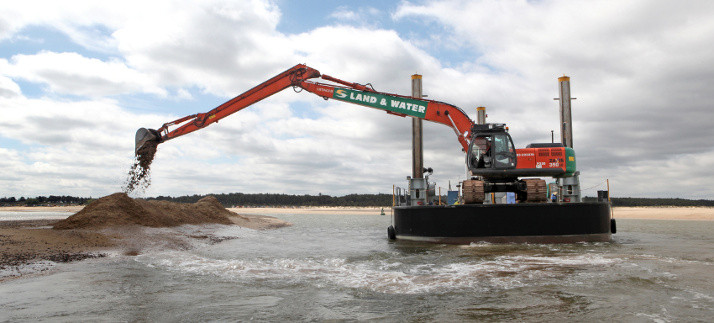Overview:
The shoreline of Lake Norman is generally well protected by the combined efforts of Duke Energy, Federal Energy Regulatory Commission, county governments, and local residents. Lake Norman is in fact one of the Catawba River Basin’s cleanest lakes, but due to it’s size, it requires maintenance and constant attention. However, due to Lake Norman’s size and importance in the local economy, the fragile ecosystem still faces a number of threats. These are primarily:
- erosion and run-off pollution,
- recreational usage,
- sewage,
- potential coal ash threats, and
- dredging.
Erosion and Run-Off Pollution:
The most common issues are increased sedimentation from erosion and stormwater run-off, due to increased urbanization surrounding the lake. Run-off can carry fertilizer, pesticides, oil, soap, sediment, or sewage overflow, all of which pollute the ecosystems on the lake’s shoreline. Contaminated sedimentation can settle in the lake, causing problems for organisms that rely on lake bed nutrient cycling, as well as those organisms that utilize this space for a habitat. Storm drains like the following help catch potentially contaminated run-off.
One of the best ways to naturally deal with run-off is to have an intentionally maintained riparian buffer zone, such as the one seen below. The term riparian buffer is used to describe lands adjacent to streams where vegetation is strongly influenced by the presence of water. They are often populated by native grasses, flowers, shrubs and trees that line the shore. A healthy riparian area is evidence of wise land use management. The roots of trees and shrubs hold the sediment firm, decreasing water erosion to the bank. Additionally, riparian buffer zones prevent surface runoff from moving too quickly over land, allowing water to filter into the soil and recharge groundwater. Natural areas compose only .4% [INSERT LINK TO GRAPHIC HERE] of Lake Norman’s shoreline, indicating that our shore is at higher risk of erosion and groundwater depletion.
Recreational Usage:
Hydrocarbons such as oil, gas, and grease are organic compounds that are made up of carbon-hydrogen bonds. Hydrocarbon pollutants can result in negative health impacts to humans and wildlife. One major source of hydrocarbon polluting occurs through boating traffic, which includes both physical debris and fuel spills. Gas stations with pumps directly on the lake are one way to minimize spillage of oil and fuel as boaters are able to pump directly into their boats and do not risk leakage from a vessel such as a gas can, which can often be unwieldy. Lastly, littering on the lake can earn a fine, which is enforced by Lake Patrol, a subset of each county’s police force that ensure boaters are safe. These restrictions combine to deter visible anthropogenic pollution resulting from public recreation.
Sewage:
Another pollutant coming from individual human sources is septic waste, due to the popularity of outdated septic systems and poor soil conditions in some local areas. As septic systems grow old, the walls containing household wastes and feces degrade. When these systems burst, they risk contaminating local groundwater with fecal coliform bacteria, which upsets the nutrient balance in the water and causes potential health risks for humans and other animals.
Coal Ash:
More recent concerns have sprung up regarding the adjacent coal ash pond facilities at Duke Energy’s Marshall Steam Station as well. Given the failure and massive discharge of the coal ash pond into the Dan River in February of 2014, increased regulation and monitoring may soon be set in place. The proximity of this coal ash pond to the waters of Lake Norman pose a potential threat to the water quality, should any accident occur.
Dredging:
Dredging is the excavation of material from lake beds and other water bodies. Most dredging is done to construct a dock[INSERT LINK HERE] and maintain or deepen navigation channels for boat traffic. Dredging activities have significant impacts on aquatic habitats and species:
-The substrate is removed, resulting in habitat and species removal.
- -The lake bed topography and hydrography is shifted, resulting in physical stress to aquatic species.
– The sediment composition is altered causes a decline in species density and abundance.
– The re-suspension of sediments increases turbidity (cloudiness) of the water. With increased turbidity, the spread of sediments and associated contaminants in the surroundings releases nutrients resulting in eutrophication and negative impacts on organisms due to decreased oxygen levels and transparency.
Sources:
Anonymous
2014 Urban Runoff. Electronic document, http://en.wikipedia.org/wiki/Urban_runoff, accessed April 5, 2014.
Anonymous
Dredging with long reach excavator. Electronic document, http://commons.wikimedia.org/wiki/File:Dredging_with_long_reach_excavator.jpg, accessed April 5, 2014.
Anonymous
Gasoline Spill. Electronic document, http://sustainablewater.org/wp-content/uploads/2013/11/gasoline-spill-11638779.jpg, accessed April 5, 2014.
Anonymous
Scherer Plant. Electronic document, http://upload.wikimedia.org/wikipedia/commons/d/d7/Schererplant.jpg, accessed April 4, 2014.
Anonymous
Septic System. Electronic document, http://farm7.staticflickr.com/6046/6330991964_0920a7e8f8_o.jpg, accessed April 4, 2014.
Catawba River Keeper
2014 Coal Ash. Electronic document, http://www.catawbariverkeeper.org/issues/coal-ash, accessed March 16, 2014.
Catawba River Keeper
2014 Lake Norman Page. Electronic document, http://www.catawbariverkeeper.org/our-work/covekeepers/lake-norman-page, accessed March 2, 2014.
Catawba River Keeper
2014 Overview of Sewage Issues. Electronic document, http://www.catawbariverkeeper.org/issues/library-of-documents-on-sewage-issues-and-treatment/overview-of-sewage-issues, accessed April 1, 2014.
EPA, US
2013 Dredging and Dredged Material Management. Electronic document, http://www.epa.gov/region2/water/dredge/, accessed February 28, 2014.
Mecklenburg County
2011 Protecting Our Lakes. Electronic document, http://charmeck.org/stormwater/creekslakesponds/lakes/documents/protectinglakewaterquality2011.pdf, accessed April 1, 2014.
Mecklenburg County Water Quality Program, Land Use and Environmental Service Agency
2005 Protecting Water Quality in Our Lakes. Electronic document,http://www.nclakemanagement.org/workshops/workshop2010/presentations/WatershedBooklet.pdf, accessed March 16, 2014.
North Carolina State University
Stream Notes: Riparian Buffers. Electronic document, http://www.bae.ncsu.edu/programs/extension/wqg/sri/riparian5.pdf, accessed March 15, 2014.
Ospar Commission
2010 Quality Status Report. Electronic document,http://qsr2010.ospar.org/media/assessments/p00366_supplements/p00366_suppl_1_dredging_what_are_the_problem.pdf, accessed March 1, 2014.
Vance, Katherine
Pond. Electronic document, http://www.pecva.org/library/images/water/pond_credit_katherine_vance400x.jpg, accessed April 5, 2014.





